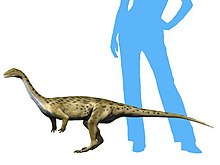Saturnaliidae is a family of basal sauropodomorph dinosaurs found in Brazil, Argentina and possibly Zimbabwe.[1] It is not to be confused with Saturnalidae, a family of radiolarian protists.[2]
| Saturnaliids Temporal range: Late Triassic,
| |
|---|---|

| |
| Life restoration of Saturnalia tupiniquim | |
| Scientific classification | |
| Domain: | Eukaryota |
| Kingdom: | Animalia |
| Phylum: | Chordata |
| Clade: | Dinosauria |
| Clade: | Saurischia |
| Clade: | †Sauropodomorpha |
| Family: | †Saturnaliidae Langer et al., 2019 |
| Type species | |
| †Saturnalia tupiniquim Langer et al., 1999
| |
| Genera | |
| Synonyms | |
| |
Classification
editIn 2010, Martin Ezcurra defined the subfamily Saturnaliinae for the clade containing Saturnalia and Chromogisaurus, which were found to be close relatives in several studies.[1] While they are sometimes found to be a subgroup within the Guaibasauridae,[1] all recent studies have found the saturnaliines to form an independent lineage at the very base of the sauropodomorph family tree.[3][4][5][6][7][8][9] At one point, Agnosphitys was recovered as a possible saturnaliine until it was recovered as a member of Silesauridae in 2017.[10] Langer and colleagues (2019) recovered Pampadromaeus and Panphagia as relatives of Saturnalia and Chromogisaurus, elevating Saturnaliinae to family rank as Saturnaliidae. In that particular paper, they recovered Guaibasaurus as a basal theropod.[11]
Additionally, Eoraptor, Buriolestes, Bagualosaurus and especially Nhandumirim are also possible members of this clade following their position in many recent phylogenetic analyses[4][5][6][7][8][9] and the new definition given by Langer et al. (2019), as "the maximal sauropodomorph clade to encompass Saturnalia but not Plateosaurus."[11] In several of these analyses, Guaibasaurus is recovered as distantly related to Saturnalia, sometimes as a more basal sauropodomorph or saurischian, and in some cases specifically related to more derived taxa such as Macrocollum and Unaysaurus. This way a Guaibasauridae including Saturnalia and kin is no longer being supported.
References
edit- ^ a b c Ezcurra, Martin D. (2010). "A new early dinosaur (Saurischia: Sauropodomorpha) from the Late Triassic of Argentina: a reassessment of dinosaur origin and phylogeny". Journal of Systematic Palaeontology. 8 (3): 371–425. Bibcode:2010JSPal...8..371E. doi:10.1080/14772019.2010.484650. S2CID 129244872.
- ^ "IRMNG - Saturnalidae Deflandre, 1953 †". www.irmng.org. Retrieved 2021-11-24.
- ^ Cecilia Apaldetti; Ricardo N. Martinez; Oscar A. Alcober & Diego Pol (2011). Claessens, Leon (ed.). "A New Basal Sauropodomorph (Dinosauria: Saurischia) from Quebrada del Barro Formation (Marayes-El Carrizal Basin), Northwestern Argentina". PLOS ONE. 6 (11): e26964. Bibcode:2011PLoSO...626964A. doi:10.1371/journal.pone.0026964. PMC 3212523. PMID 22096511.
- ^ a b Pacheco, Cristian; Müller, Rodrigo T.; Langer, Max; Pretto, Flávio A.; Kerber, Leonardo; Dias da Silva, Sérgio (2019-11-08). "Gnathovorax cabreirai : a new early dinosaur and the origin and initial radiation of predatory dinosaurs". PeerJ. 7: e7963. doi:10.7717/peerj.7963. ISSN 2167-8359. PMC 6844243. PMID 31720108.
- ^ a b Novas, Fernando E.; Agnolin, Federico L.; Ezcurra, Martín D.; Temp Müller, Rodrigo; Martinelli, Agustín G.; Langer, Max C. (October 2021). "Review of the fossil record of early dinosaurs from South America, and its phylogenetic implications". Journal of South American Earth Sciences. 110: 103341. Bibcode:2021JSAES.11003341N. doi:10.1016/j.jsames.2021.103341.
- ^ a b Garcia, Maurício S.; Müller, Rodrigo T.; Pretto, Flávio A.; Da-Rosa, Átila A. S.; Dias-Da-Silva, Sérgio (2021-01-02). "Taxonomic and phylogenetic reassessment of a large-bodied dinosaur from the earliest dinosaur-bearing beds (Carnian, Upper Triassic) from southern Brazil". Journal of Systematic Palaeontology. 19 (1): 1–37. Bibcode:2021JSPal..19....1G. doi:10.1080/14772019.2021.1873433. ISSN 1477-2019. S2CID 232313141.
- ^ a b Müller, Rodrigo T. (April 2021). "A new theropod dinosaur from a peculiar Late Triassic assemblage of southern Brazil". Journal of South American Earth Sciences. 107: 103026. Bibcode:2021JSAES.10703026M. doi:10.1016/j.jsames.2020.103026. S2CID 229432076.
- ^ a b Müller, Rodrigo Temp; Garcia, Maurício Silva (August 2020). "A paraphyletic 'Silesauridae' as an alternative hypothesis for the initial radiation of ornithischian dinosaurs". Biology Letters. 16 (8): 20200417. doi:10.1098/rsbl.2020.0417. ISSN 1744-9561. PMC 7480155. PMID 32842895.
- ^ a b Müller, Rodrigo T; Langer, Max C; Bronzati, Mario; Pacheco, Cristian P; Cabreira, Sérgio F; Dias-Da-Silva, Sérgio (2018-05-15). "Early evolution of sauropodomorphs: anatomy and phylogenetic relationships of a remarkably well-preserved dinosaur from the Upper Triassic of southern Brazil". Zoological Journal of the Linnean Society. doi:10.1093/zoolinnean/zly009. ISSN 0024-4082.
- ^ Baron, M.G., Norman, D.B., and Barrett, P.M. (2017). A new hypothesis of dinosaur relationships and early dinosaur evolution. Nature, 543: 501–506. doi:10.1038/nature21700
- ^ a b Langer MC, McPhee BW, Marsola JCdA, Roberto-da-Silva L, Cabreira SF (2019) Anatomy of the dinosaur Pampadromaeus barberenai (Saurischia—Sauropodomorpha) from the Late Triassic Santa Maria Formation of southern Brazil. PLoS ONE 14(2): e0212543. https://doi.org/10.1371/journal.pone.0212543